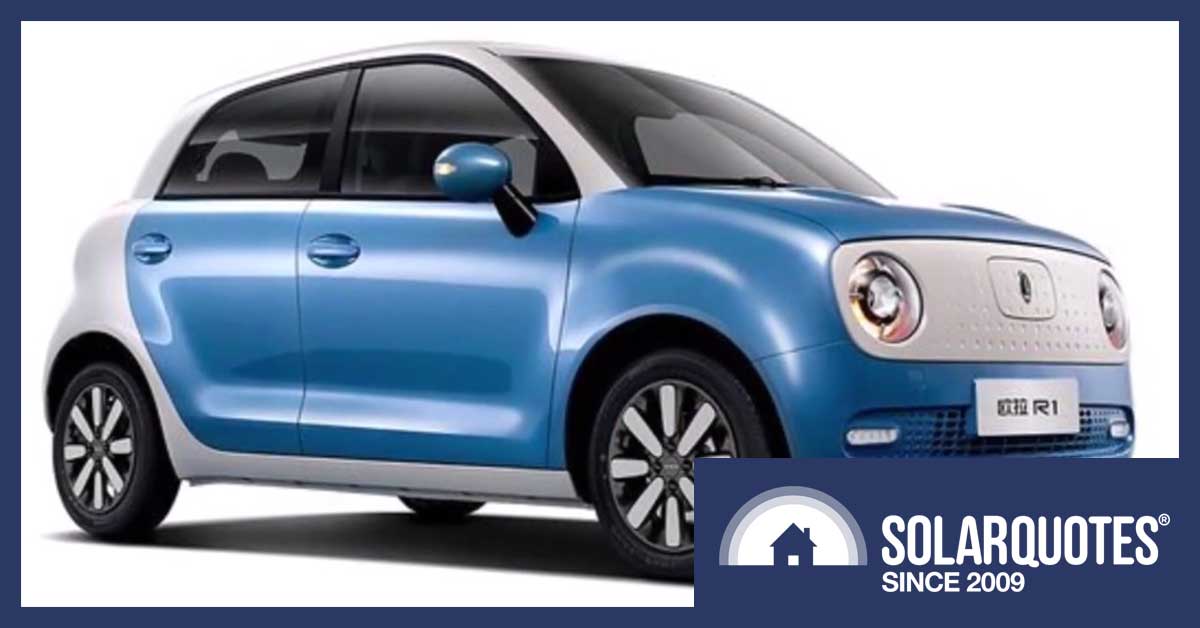
Does this electric car really cost less than $13,000? Err, unfortunately no.
Great Wall Motors has has released the electric ORA R1 passenger car in China. Or at least I think they have.
I can’t be certain because the Great Wall Motors website has no information about it in any of my favorite languages.1 Fortunately, they put out a press release so I can be certain it’s not a hoax by a bored graphics designer. But even if it was a hoax there are now so many articles on the internet about it that enough belief has probably been generated to will the EV into existence like an electric vehicle version of Leonardo Dicaprio’s acting talent.
By poking around on the internet I was able to discover the EV was developed as a joint venture with BMW . But it seems most people writing about the ORA R1 have been unwilling to do even a minimal amount of poking because most of the eleventy billion2 or so articles I’ve seen on it are chock full of bullshit. This bullshit includes claims that…
- It’s the cheapest electric car in the world — this is complete bullshit.
- It’s the cheapest electric car in China — absolute bullshit.
- Its range is 320km — bullshit, but bullshit that started with Great Wall Motors.
- Its cost is $12,230 to $15,910 in China — This may be the price people pay in China but because it’s heavily subsidised the total cost is much higher.
The vehicle will only be sold in China but BMW appears to be planning to produce something similar this year, though I’m sure their version will have a more powerful motor. Some technical details of the Chinese vehicle are:
- It has a 33 kilowatt-hour battery pack.
- When its battery pack is flat it can be “supercharged” from 0% to 80% in 40 minutes.
- Its small motor can only provide 35 kilowatts of power to the wheels.
- Its top speed is around 100 km/h
- Its real world range may be 240km.
Just how much the car receives in national and local subsidies is difficult to determine but it may be about $14,000. This makes the electric car’s total cost around $26,000 to $30,000.
Here’s a boring video that shows everything you might want to know about the car — except whether or not the EV is capable of moving under it’s own power:
Great Wall Motors
As hard as it may be to believe, the Great Wall Motors company has nothing to do with Donald Trump and his plan to build a wall and make Mexico pay for it.
Apparently, it’s named after some completely unrelated wall in China.3
In Australia Great Wall Motors sells petrol and diesel powered utes. They also sell big boxy passenger cars but they do it under the Haval brand rather than Great Wall Motors. I don’t know why. Maybe it’s to avoid upsetting Mexicans.4
Their headquarters are in Baoding, which is 140km south-west of Beijing. It is a god-awful place. Not only is the weather horrible but the pollution is so bad the air in summer is like inhaling gun powder and in the winter it’s like breathing weak acid laced with a dash of whale urine.

The Baoding pollution value at the top isn’t in decicigarettes per hour, but perhaps it should be.
With air quality like that it’s not surprising they want to build electric cars. The city also produces many of the wind turbine blades used in China. I presume this didn’t start as part of a loony plan to build giant fans to blow the smog away, but I have no evidence this isn’t actually the case.

Here’s a major reason why life expectancy is six years longer in Australia than China. (There’s hardly any whale urine in the air at all.)
Its Range Is Not 300+ Kilometers
A lot of articles on the ORA R1 give its range as 200 miles but that is totally fake news. It’s actual fake range is 194 miles or 310 kilometers. I describe that as fake because it uses the NEDC or New European Driving Cycle, which is similar to a game of Dungeons and Dragons because it’s a fantasy that relies heavily on randomly generated numbers. Car manufacturers are — to an extent — allowed to cheat when their car’s fuel efficiency is tested and so it greatly overstates the real world range of vehicles. Under realistic conditions ORA R1’s range may be around 240 kilometers. This means it would be able to get 7.3 kilometers per kilowatt-hour from its 33 kilowatt-hour battery pack, which should be reasonable for a small electric car with a low power motor.
Its Top Speed Isn’t Great
The top speed of the ORA R1 is around 100 kilometers per hour. But I’ll mention the average adult in China weighs 62kg while in Australia it’s 77kg, so if I was driving it might not quite manage 100 km/h thanks to my advanced muscularity. The reason the top speed is so low is because the EV’s motor can only provide 35 kilowatts of power to the wheels. My Hyundai Getz5 can provide 70 kilowatts. Around town a 35 kilowatt electric motor gives much better performance than a 35 kilowatt internal combustion engine, but the low power still limits highway speeds. I don’t know how well the ORA R1 will perform around town but with such a small motor it will definitely be less nippy than most electric cars.
Its Cost Is Still High
The ORA R1 is definitely not the cheapest electric car in the world. It’s not even close to being the cheapest electric car in China. The internet tells me there are all sorts of weird and wonderful Chinese electric vehicles available at a lower price. Maybe it’s the cheapest in a particular category, or the cheapest “real boy” car, but I’m too lazy to learn Mandarin and find out.
With a total cost of perhaps $26,000 to $30,000 once subsidies are included, it’s not cheap compared to a similar sized conventional new car in China which can be around $10,000. But thanks to the subsidies Chinese citizens pay less than $16,000 for the ORA R1 and with it’s low maintenance and fuel costs6 it should make a good buy for anyone who drives a reasonably high number of kilometers per year. Great Wall Motors says the “core components” have a warranty of 8 years. If that includes the battery pack it should last long enough for the car to be a worthwhile purchase for many drivers.
China Leads The World In Electric Car Production
China is going into electric car production in a large way. Roughly half the electric cars in the world are made in China for use in China. One reason for this rapidly increasing EV output is they want to be able to breath and another reason is the Chinese economy is very vulnerable to disruptions in oil supply and they’d prefer to be less vulnerable. The Chinese Communist Party7 is probably concerned Trump will try to build a wall across the Myanmar oil pipeline. They’re also aware that, as the world’s largest oil importer, their increasing consumption — along with depletion — is keeping oil prices high.
Last year China produced around 754,000 electric cars, which is 3% of their total vehicle production. While this may not seem like much, EV production is expected to rapidly increase and could follow a similar trajectory to electric bus manufacturing where they now dominate world production like a Colossus. Currently China has around 350,000 electric buses which is one for every 4,000 people.8 While China imports more vehicles than they export at the moment9, it seems certain many electric cars sold in Australia in the future will be made in China.

“Gentlemen, if you harbour any insecurities at all, then for god’s sake, don’t look up.”
Footnotes
- English, Australian, British, Dutch, Double Dutch, Triple Dutch, and the international language of love — including the Japanese dialect where the semaphore flags are replaced with tentacles. ↩
- I’m a trustworthy source on account of how I NEVER exaggerate. ↩
- People make fun of Trump’s plan to build a Great Wall of the United States, but actually he’s so intelligent people of lesser intellect are simply unable to comprehend it’s all part of his plan to resurrect Ronald Reagan. He has used secret Russian technology to create 20 young Ronald Reagan clones and hidden them in Mexico. But it’s not enough to get Reagan’s DNA right. The life experiences of the clones also have to be similar so Trump needs to build a wall for them to want to tear down. ↩
- In Queensland, Mexicans are everyone who lives south of the town of Texas. ↩
- That I keep in the back of my Hummer. ↩
- Residential electricity is a vast number of smidgens cheaper in China than Australia, while petrol costs very roughly the same. ↩
- At this point it’s probably much more accurate to just call it the Chinese “We’re In Charge” Party. ↩
- Australia has around one bus per 300 people so they no doubt have a way to go before all their buses are electric, but they are getting there. ↩
- Although fewer American cars lately on account of Trump building a tariff wall and making everyone pay for it. ↩


 RSS - Posts
RSS - Posts



The figures suggested for the EV with a 33Kw battery pack really calls into question the prices being charged in Australia for ESS systems.
Elon Musk of Tesla says the cost of their battery cells should be down to $140 a kilowatt-hour by now. Even if they’re not quite there yet we can be certain the price isn’t too far off and other electric car manufacturers are receiving cells for around $200 per kilowatt-hour. Even assuming that putting them in a home energy storage unit triples the price that’s $600 a kilowatt-hour instead of the around $1,000 a kilowatt-hour larger units cost currently. Clearly there is a lot of room for home energy storage to come down in price.
When supply starts to catch up with demand I’m sure Tesla will move the price down but I’m sure everyone else is just watching them, waiting for them to move. It’s unfortunate we don’t have any true competition in this space yet.
So a full ‘tank’ in my country would be 24usd in stead of the 60usd I am paying right now. Wish I had the money to import one!! (#curacao has only 1 company that is allowed to import gasoline and 1L is now 1.14usd)
Nice one Ronald, digging deep into the bullshit as always.
I think it’s worth pointing out (and repeating over and over again) that electric cars don’t REMOVE air pollution they just MOVE it. I know I don’t have to tell you this but every time I read how such and such a place is switching to electric cars to reduce air pollution I want to scream because there is NEVER a discussion about where the electricity comes from.
Some of China’s air pollution comes out the arse end of ICE vehicles but the worst of it comes from dirty coal-fired power plants. Just in case anyone was not aware… these make ELECTRICITY! So switching from a dirty petrol or diesel powered ICE vehicle to a dirty coal-powered electric vehicle just moves the pollution from the tail pipe to the smoke stack.
Every discussion about electric vehicles and pollution has to include a discussion about the percentage of renewable energy in the electricity grid.
Many years ago a friend of mine in Montana (where the electricity grid is almost entirely coal-powered) saw his tech-CEO mate drive up in a brand new Telsa Roadster which he’d just paid US$150.000 for. He gets out all proud of himself and my friend says, “I see you’ve swapped your gas-powered sports car for a coal-powered one”. The tech guy was not amused but he put solar panels on his house immediately.
Chinese coal average roughly 28 megajoules per kilogram and emits roughly 2.3 kg of CO2 when burned. The average efficiency of China’s coal fleet is the second highest in the world after Japan and is around 39% so each kilogram of coal burned generates about 3 kilowatt-hours. A Chinese electric car might get 6 kilometers per kilowatt-hour after losses. So if an electric car was charged entirely with Chinese coal power it would result in around 128 grams of CO2 emissions per kilometer driven.
Including emissions from refining and transport burning a liter of petrol results in around 2.6 kg of CO2 emissions. If an internal combustion engine car gets 15 kilometers per liter it will result in 173 grams of CO2 per kilometer driven.
So when it comes to CO2 emissions even when charged entirely with coal an electric car should result in lower CO2 emissions than a similar sized petrol powered car. As Chinese coal generation is now close to 60% of their total the actual emissions that result will be considerably less. Obviously we want to reduce CO2 emissions from electricity generation as rapidly as possible, but electric cars should reduce CO2 emissions basically everywhere compared to using a standard petrol powered car. In some places a fuel efficient hybrid will come out ahead.
Thanks again Ronald, good point about CO2 emissions.
What about particulate emissions? The fact that it’s hard to breath in parts of China is not due to too much CO2 pollution.
I don’t have time to do the research right now but I’m wondering how the particulate emissions from an ICE vehicle compare to those from an electric car.
By the way, I drive a PHEV and I love it. I’m not advocating against electric vehicles, quite the opposite. I AM advocating for an honest discussion about true costs, benefits, pollution and emissions from one versus the other.
Generally pollution from cars has a much worse effect on health than pollution from coal power pollution stations. This is because vehicle pollution is emitted at ground level where people are. Here in Australia where most electricity is generated from coal vehicle pollution kills more people. Of course which is worse can depend on local conditions.
Well you want some real comments?
It is about 2 months overdue but the reason is I actually bought one 27 January. The Ora R1. This after checking out the Chinese Electric car industry for half a year. I sold my Geely and ordered this one 2 days after the Chinese release 26 Dec 2018. I have lived in China for the last 2 year and have lived here in the South province of Guangzi to and from for the last 10 years. I also lived in Australia for 10 years in the past. I an a retired Swede. Enough about me.
It was a reasonable gamble to buy this car, but it surprises me on all accounts. First the motor power, 35 kW direct to the wheels from stand still is enough to have the feel you own the city road. Highway is no problem if you can cope with 100km/h it actually does 107 and is probably a set speed becouse he does the same speed uphill and downhill on the Freeway.
About the range, If I drive slowly like an old lady. I would get 400 km in town but a resonable range is 300+ with my semi aggressive driving with aircon on.
Drove the other day in 8+ degree C heavy rain wipers, light and heater City cycle. Meter showed 13 kWh per 100 km (130 Wh per 10 km) and it is thru distance no fake according to my phones Gps. Drove down the coast Freeway 150 km and back all 300km had 6% left in the battery at home.
A little scary but all for the test. I could have quick charged at the coast: 20 min to full.
My ordinary driving reads around 800wh per 10 km. I was afraid the smaller battery 32.8 kWh should not be enough but I only charge once a week at home and drive over 300 km. Cable from the 5th floor, gets a bit warm 2800W charger but it sucks 3300 on the meter about 18% loss not a big deal. If charged from a station loss will be smaller
Small on the outside big on the inside. Have seated four 80+ kg Swedes with enough legroom both front and back all tall guys about 180cm. All said it was a comfortable ride and you don’t notice any sluggish performance. It has an empty weight of 990 kg including batteries and a total with loads of 1300kg.
It is one of the funniest best drive I have had Total balance and with my 64 years 42 years driving 25+ owed cars including 2 BMW and a Holden I think I can judge this.
Price 69 000 Rmb and 40 000 in Government subsidy. It can and will at least come to Europe. Should not be a bigger hike in price elsewhere.
The cooperation with BMW is only that Great Wall is going to make British Mini into electric. Mini is a subsidary of BMW
The ora1 is designed by a Japanese team and full in class with western car standards.
Thank you very much for telling us about its real world performance. Its 35 kilowatt motor does a lot better on the highway than I expected.
Normal driving is 800 Wh per 10 kms? That’s 12.5kms per kWh, or just over 7.7 miles per kWh. even in cold conditions, heater on he got 7.75kms per kWh which is still OK for city cycle in cold temps.
That’s very efficient for a vehicle touching the scales at 990kg before passengers. I can understand Ron’s scepticism but it seems they haven’t gamed the system.
Is it strange that Leif didn’t buy a LEAF? At the very least it’s disappointing..
That rendition of the Colossus of Rhodes is supposedly either already under construction, or should be soon. Hopefully it will last longer than the original which was destroyed by an earthquake (but you knew this already didn’t you) ? 😉
Yes! I knew that! Of course, the Colossus of Rhodes was definitely destroyed in an earthquake. I certainly had nothing to do with it. And if I did, which I didn’t, no one saw me. Any stories about a drunk Captain telling the Colossus to get out of his way certainly don’t involve me.